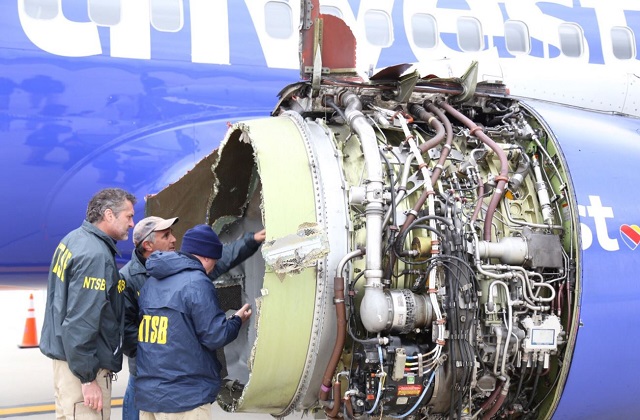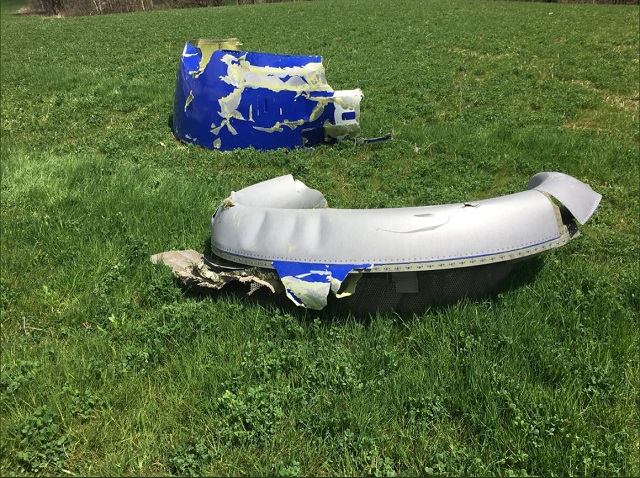Federal regulators in 2017 proposed inspections aimed at preventing engine failures like the one that damaged a Southwest Airlines Boeing 737-700 and killed one passenger on 17 April.
Since then, the document has worked through a lengthy federal review process and been subject to comments from airlines, some of which requested more time to complete proposed engine inspections.
The FAA, already under pressure following a critical 60 Minutes report last week, now says it will issue a final airworthiness directive (AD) in the coming weeks.
But it remains unclear if that proposal, had it been issued earlier, might have prevented the Southwest incident, which was caused by the poorly-understood and exceedingly-rare problem of internal cracks in the fan blades of CFM International CFM56-7B engines.
"They can't get a good handle on this," former National Transportation Safety Board member John Goglia tells FlightGlobal. "It's not well understood. We can see the physical results behind [failures], but the cause and the actual mechanism that led to the failure is not so plain to see."
He adds that today's high-bypass engines have larger fan blades than previous-generation engines; when modern blades fail, they can cause more damage.
"As we go to bigger and bigger high-bypass engines and bigger, more-efficient blades, we have been getting more mass in that rotation, which means more damage if [a blade] becomes separated," Goglia says.
On 17 April, Southwest pilots made an emergency landing after their Boeing 737-700's left-side CFM56-7B22 powerplant exploded, damaging the aircraft with shrapnel and breaking a window, which killed one passenger. The aircraft had been operating flight 1380 from LaGuardia to Dallas, but diverted to Philadelphia.

NTSB.
NTSB investigators already traced the failure to a broken fan blade. They found an "internal" crack in the blade near where the blade meets the engine hub.
The FAA responded on 18 April, saying it "will issue an airworthiness directive within the next two weeks that will require inspections of certain CFM56-7B engines."
"The directive will require an ultrasonic inspection of fan blades when they reach a certain number of takeoffs and landings. Any blades that fail the inspection will have to be replaced," the statement said.
Engine maker CFM is also working with the FAA and airlines as it writes an updated service bulletin – one that likewise recommends inspections, that company says.
"We are meeting with the FAA today on timing," CFM tells FlightGlobal. "You can expect a [service bulletin] with immediate FAA endorsement through an AD."
"The actual numbers are being reviewed finalised with the FAA," CFM adds. "The major airlines know it is coming, so those with the largest fleets are prepared."
KNOWN PROBLEM
Those responses build on previous work to address an issue that became salient after the August 2016 inflight failure of a CFM56-7B22 on a Southwest 737-800 over the Gulf of Mexico. The aircraft lost the engine cowling, and the pilots landed safely with no passenger injuries.
Though the NTSB has not issued its final findings, the 2016 event caught everyone's attention.
In a service bulletin issued in March 2017 and updated in June 2017, CFM recommended airlines "as soon as possible" ultrasonically inspect blades in CFM56-7Bs that had accumulated more than 15,000 cycles since a shop visit.
"Investigation has identified a crack that initiated and propagated in fan blade dovetail," says the June update. The dovetail is the end of the blade that fits into the engine hub.
As a matter of proportion, the CFM56-7 has accumulated 350 million flight hours with few problems, according to CFM.
The FAA responded in August 2017 with the proposed airworthiness directive. It proposed requiring airlines, within six months, to ultrasonically inspect fan blades on CFM56-7Bs that had accumulated more than 15,000 cycles since a last shop visit. Engines with less than 15,000 cycles would need inspections within 18 months, the FAA proposed.
The agency estimated 220 engines in service with US airlines would be affected.
"This proposed AD was prompted by a report of an in-flight fan blade failure and uncontained forward release of debris on a CFM56-7B turbofan engine," says the proposal. "The fracture in the blade initiated from the fan blade dovetail."
The industry took no major issue with the 2017 proposal, though some airlines requested longer compliance times. They said the rule would affect more than 220 engines because airlines often swap blades between engines.
CFM actually asked the FAA to reduce from 18 months to 12 months the inspection deadline for engines with less than 15,000 cycles since a shop visit.
Southwest disagreed with CFM, asking for 18 months to inspect 732 affected engines; American Airlines asked for 20 months.
The FAA says the document had been working through the lengthy federal regulatory review process for months, and that it had been weeks away from becoming an AD even before the 17 April Southwest incident.
But the AD might not have applied to the Southwest aircraft anyway. On the day of the accident, Southwest chief executive Gary Kelly said the engine had accumulated 10,000 cycles since a shop visit – below the FAA's proposed 15,000-cycle threshold for urgent inspections.
Following the accident, Southwest said it would inspect all its engines, but the company has not said if it had started or completed any checks prior to the accident.
"FORWARD RELEASE"
Like in 2016 incident, the 17 April engine explosion may not technically qualify as an "uncontained failure" – a term meaning a blade penetrated the casing around the fan, says Goglia.
"You can see the containment ring, and it's still on the engine," Goglia says after viewing NTSB photographs of Southwest flight 1380. "Further back… you see the containment ring. It's totally intact."

NTSB.
The blade broke near the hub, according to the NSTB. It apparently flew forward, hitting the forward part of the cowling and causing the cowling to disintegrate into shrapnel that damaged the aircraft, Goglia suspects.
Investigators retrieved parts of the cowling on the ground 65nm (120km) from Philadelphia, the NTSB said.
"Everybody has been saying it's an uncontained engine failure. It isn't by the FAA definition," Goglia says.

NTSB.
Experts studying such failures believe the forward trajectory results from pressure behind the blades, he adds.
But the extreme rarity of such failures and complexity of forces involved make testing, understanding and predicting blade failures difficult.
The blades whirl thousands of times per minute, forcing cold outside air into hot aft sections, Goglia notes. And incidents like bird strikes, even those years ago, might theoretically degrade blade strength.
"[Engine makers] are using the very best materials they can get their hands on, but we are still learning," he says. "In order to get that knowledge, there is got to be a lot of testing on blades to get them to break on the ground."
Fixing the problem now rests with the FAA, CFM and airlines. One possible solution could be to require airlines to replace blades after a specified number of cycles – throw them out and replace them with new blades, Goglia says.
But blades are "brutally expensive", and airlines would likely be wary of a "knee jerk" reaction to a poorly-understood problem, he says.
Source: Cirium Dashboard



















